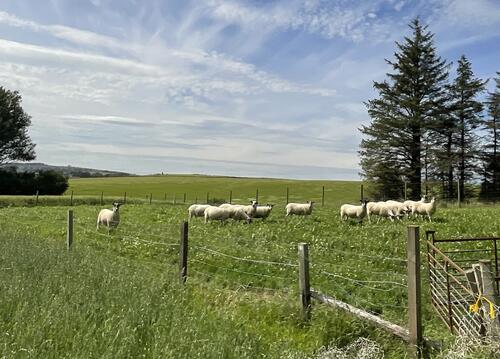Introduction
“We are bringing a network of people and key organisations together who provide food or feed in organic and non-organic systems. Working in an interdisciplinary manner we are co-creating long term partnerships with our stakeholder communities.” Said Professor Christine Watson, Deputy Head of the School of Natural and Social Sciences (Research), SRUC, as we were welcomed to their fabulous state of the art building at Craibstone.
Christine has been visionary in her approach to building partnerships, with the University of Aberdeen, The Rowett Institute, The James Hutton Institute, Moredun and of course, SEFARI Gateway. For a long time, her research has been on the benefits of the circular economy, the recycling of nutrients, including from organic waste to the crops we grow as part of our farming systems. She stressed that good soil health was important and how good management led to increased soil carbon, increased biodiversity, and decreased emissions, working across a range of scales. We saw results of this at the lab, field, and farm scales on our visit.
Talks
We were presented with three examples of results from long term experiments. Christine talked about results from a meta data analysis from both Europe and Africa, contributing data from SRUC’s long-term experiments at Aldroughty and Tulloch farms in the north east of Scotland. She presented results showing a yield benefit from increasing the number of crops in a rotation. However, when more than four species were included, the yield started to fall from its peak. Soil acidity was shown to play a vitally important part in crop production. It has been shown to also link to the soil microbiome, where bacterial diversity increased with pH. The great success in saving the long term pH plots from SRUC was down to Christine’s tireless campaigning, resulting in the successful translocation of soils from their original plots to new plots at Ashtown farm.
The original crop trial has been providing Britain’s farmers with vital scientific data for around 60 years. Managed by SRUC, Woodlands Field has been home to a pH gradient rotational experiment since 1961. Its continued existence is due to a great partnership between SRUC and the University of Aberdeen, which owns the recipient field. Approximately 450 tonnes of soil was moved using excavators, tractors and trailers from its original home at Woodlands Field, Craibstone to a pre-prepared field at Tulloch to retain as much as possible the unique historical legacy of the soil’s management.
The soil is now being used for further research to improve the scientific understanding of the relationships between acidity, carbon and nutrient dynamics and help design agricultural systems with lower greenhouse gas emissions. Maintenance of the soils at different pH levels (i.e. levels of acidity) from 4.5 (very acid) to 7.5 (alkaline) has resulted in a range of distinct chemical environments and microbial communities which create a unique facility for investigating how soils, plants and microbes work together to influence productivity and to address important questions about carbon dynamics.
The Aberdeen Cropping systems Experimental (ACE) platform was created, securing the legacy of the Woodlands Field long-term pH experiment with great potential to reinvigorate cropping systems research in Scotland. Issues such as climate change, carbon sequestration, introduction of novel crops (e.g. beans, peas etc.) and alternative inputs (e.g. soil conditioners) are being investigated.
The vision for ACE is to develop and demonstrate systems and smart solutions which will deliver sustainable food and feed production through scientific understanding.
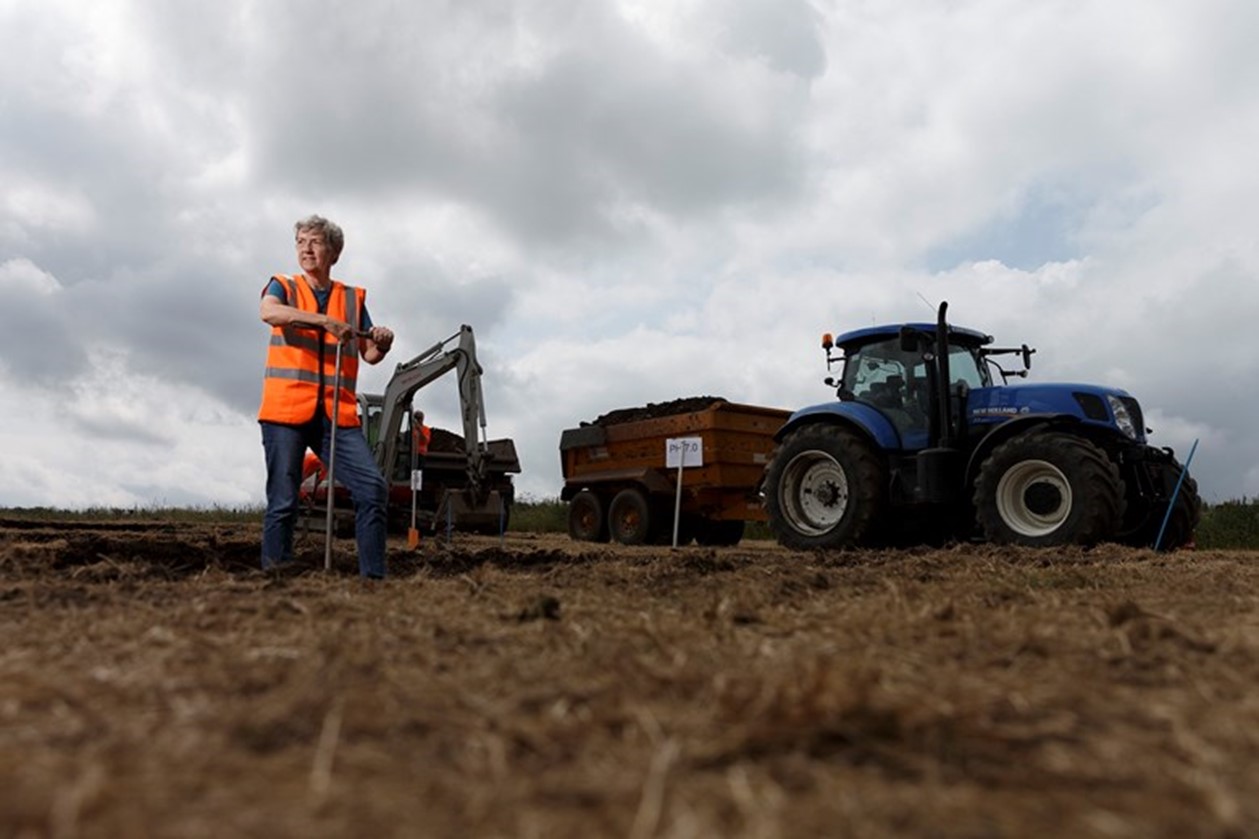
Christine Watson helping to translocate the soil profiles from the original location to their new home at Ashtown farm, part of the SRUC Craibstone Estate. Source: SRUC/Newsline media
Next up on the stage was Professor Nicola Holden, Professor of Food Safety in the School of Veterinary Medicine and Biosciences, SRUC. She talked about the importance of the One Health arena from the soil to the plant to the animal and to the human. Soil underpins everything. Microbes are doing both beneficial and detrimental things in soil all the time. Using the Soil Health score cards originally developed in the AHDB Soil Biology Soil Health programme and further refined in the Scottish Government funded Strategic Research Programme, we can use different biological metrics to quantify different aspects of the soil, depending on the required land use. The actual soil type has a great influence on the soil microbial community. Plants will then link with specific microbial functions and processes: e.g. rhizobia and N fixation. Nicola told us about the great value in the in retaining multiple microbiomes for future questions and multiple applications, preserving them in a cryobank.
Jack Horne, PhD researcher, then talked about how soil pH was a key driver of microbial function. Soil plays a vital role in many policy areas, such as food security, climate change mitigation, and also is critically important in forming the foundation of all ecosystems. My ears pricked up when he talked about a clever way to describe soils, as I used to use a vegetable curry as my model for explaining what soil was made from, while presenting evidence in court. But I liked Jack’s chilli analogy much better – I’ll use that next time in the Crown court! He described ‘the vegetables’ in the chilli as being like the soil physical structure, being affected by how much of what type of plant inputs were there (i.e. the mix of sand, silt, clay, and structural organic matter). Then he described ‘the sauce’ as being the soil chemical attributes (i.e. the reactive organic matter, the soil minerals, and the pH), while the third (and vital) ingredient, ‘the spices’ representing the soil life or the biological attributes, and those that act as the catalyst all having different properties and functions and responsive to both physical and chemical parts of the dish!
He discussed the role of two particularly interesting molecules, cobalamin, and methionine. Cobalamin, also known as Vitamin B12, plays several crucial roles in the body such as red blood cell formation, helping in the production of red blood cells, which are essential for transporting oxygen throughout the body. Cobalamin is vital for the synthesis of DNA, the genetic material in all cells. It supports the health of nerve cells and is involved in the production of myelin, the protective covering of nerves. Methionine is an essential amino acid, meaning your body cannot produce it and it must be obtained through your diet. It plays several critical roles in all organisms such as protein synthesis, necessary for the structure, function, and regulation of tissues and organs. It is involved in the process of DNA methylation, which is crucial for regulating gene expression and maintaining DNA integrity. Cobalamin (Vitamin B12) is produced by certain soil microbes that live in symbiotic relationships with plant roots and these microbes, including bacteria and archaea, synthesize cobalamin, which is essential for many organisms, including humans. The soil organisms convert cobalt, a trace element found in soil, into cobalamin. The presence of cobalamin-producing microbes could be an indicator of healthy soil. These microbes contribute to the overall nutrient cycle and support plant growth.
Methionine is a precursor to cysteine, which is used to produce glutathione, a powerful antioxidant that protects cells from damage by free radicals, helping to detoxify harmful substances in the liver. Soil microbes can utilise methionine as a nitrogen and sulphur source. This can enhance microbial activity and biomass, which in turn supports soil health and fertility. Methionine can provide a source of sulphur for plants and microbes, which is essential for various metabolic functions and can be directly taken up by plants and used for protein synthesis and other metabolic processes. This can support plant growth and development.
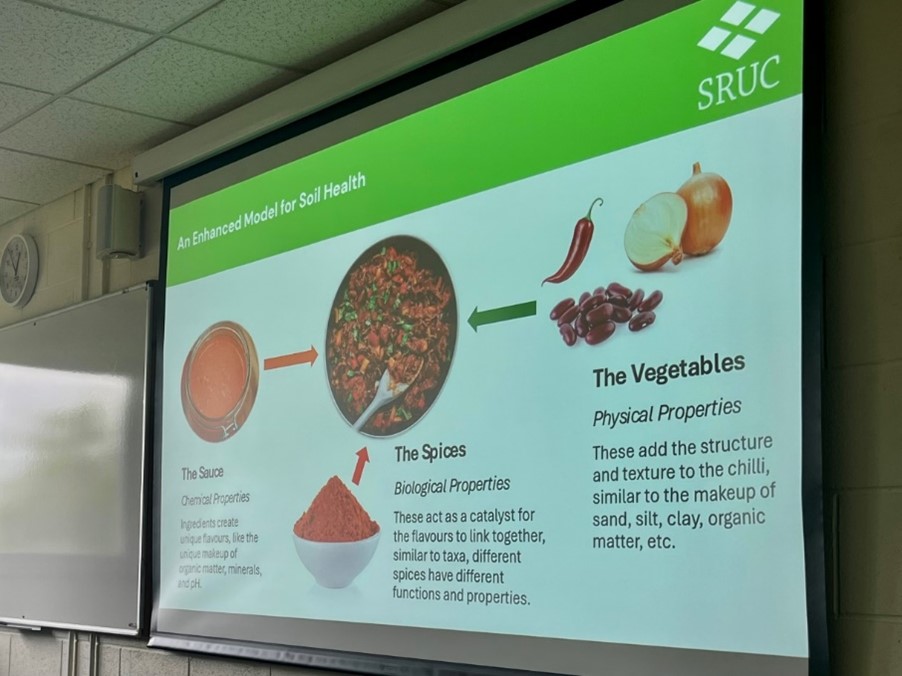
Jack’s chilli recipe slide to describe the three main components of soil. Source: Lorna Dawson.
Jack told us about his current experiment where he is looking at change in resource acquisition capacity across a range of soil pH values from 4.5 to 7.5 (in 0.5 incremental values). He is using a range of biogeochemical markers, such as microbial biomass carbon, microbial biomass nitrogen (MBN) and mineralisable nitrogen, plus deep sequencing, or Shotgun Metagenomic sequencing, using Illumina technology. MBN (and many other markers) increased with pH (to a certain level) both in the short term and long term transitions. He suggested that an enhanced model of soil health was required where soil pH was a critical factor in many of the vital soil processes. We need to further identify specific factors and marker genes to correlate with soil health-allowing rapid assessment of effect of management practices.
Professor Kairsty Topp, Professor of Agricultural Systems Modelling in the School of Natural and Social Sciences, talked about the long term experiments on different crop rotation systems. Tulloch organic rotations experiment was outlined, established in 1991 with a 6 course rotation. 3 years grass and clover, then spring barley or oats, swedes followed by an under sown oat crop. In 2007 the system changed to a stockless system and red clover was added to the pasture mix, and potatoes and wheat as well as field beans were also introduced. She described the work of former PhD student Catriona Willoughby who adopted a nutrient budget approach and compared kg protein and kg applied N in both the stocked (mixed) and stockless system. Both systems are very similar in total inputs and offtakes. However, when she looked at the phosphorus levels they were down 8% in the mixed system while they were down 200% in the stockless systems! The stockless system however had a better nitrogen use efficiency in protein and starch. Sugars, proteins and fats are key in assessing outputs. Very interesting data and I can’t wait until the full results are out.
Field visit
We were then hosted by Dr Robin Walker, Senior Lecturer, SRUC, who took us to visit the field plots. First we went to the pHoenix cropping system comparison across plots representing a wide ranging pH gradient. These were originally set up to assess the effects of a soil pH gradient on the performance of different cropping systems in terms of their soil chemical and physical properties and vegetation dynamics. In addition, economic yields were assessed. In these plots were a 5 course and a 7 course rotation as well as permanently established grassland and a multi species ley grown on the soils modified to be at a constant pH. These contain the soil relocated from the original Woodlands field soil and each with a paired plot where the soil at the new site is in the process of having its pH adjusted to match (taking a few years to settle at the target pH). The pH of the Woodlands soil plots covers a gradient from 4.5 to 7.5 and crops include spring peas, spring barley, spring beans and spring oats. Oats did best at the lower pHs, a long term Scottish staple cereal in our Scottish arable rotations, but is suffering at the pHs above 6.5, while barley really suffered at the lower pH but was more tolerant of the higher pHs. Beans also did not like the acidic pH conditions, but excelled at the higher range however. Interesting responses have been seen already in these experiments.
We were also shown the EU Intercrop VALUES site which was set up to look at the effects of intercropping (of pea and barley) on crop yield as well as other agronomic and environmental parameters compared to single species plots. There are 5 treatments on these plots- based on the single species spring barley, or pea crops, or intercropped barley and pea with varying levels on nitrogen application. Dr Luke Harrold, Post doctoral research assistant, SRUC, has been undertaking a series of measurements on several of these plots, measuring GHG emissions (in particular nitrous oxide) as well as the soil temperature and moisture, which interplay with factors such as available nitrogen. Although the first year of this experiment was adversely affected by the varieties used, this year’s varieties are responding well, with some indication of synchrony in the mixtures for ripening and interesting results are soon to be revealed. The soil underlying all these plots are fairly homogeneous so this should allow for any significant treatment effects to be determined.
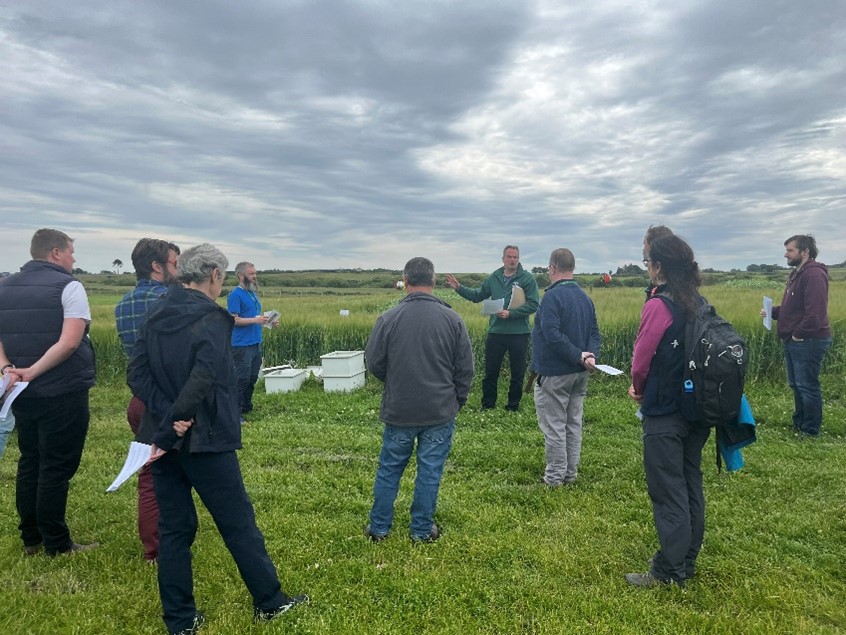
Photo of the ICValues Intercrop trial adjacent to the pHoenix pH long-term experiment being explained to the visitors by Drs Robin Walker and Luke Harrold. Source: Lorna Dawson.
After a walk over the plots we then were taken to the Tulloch site, where the effect of amendments is being examined across various stages of spring sown crops including oats, barley, kale, pea and bean. Interesting seeing possible growth responses on the sub plots where they had been treated with a ‘biostimulant’. Time will tell when the yield and nutritive values for the crops are measured.
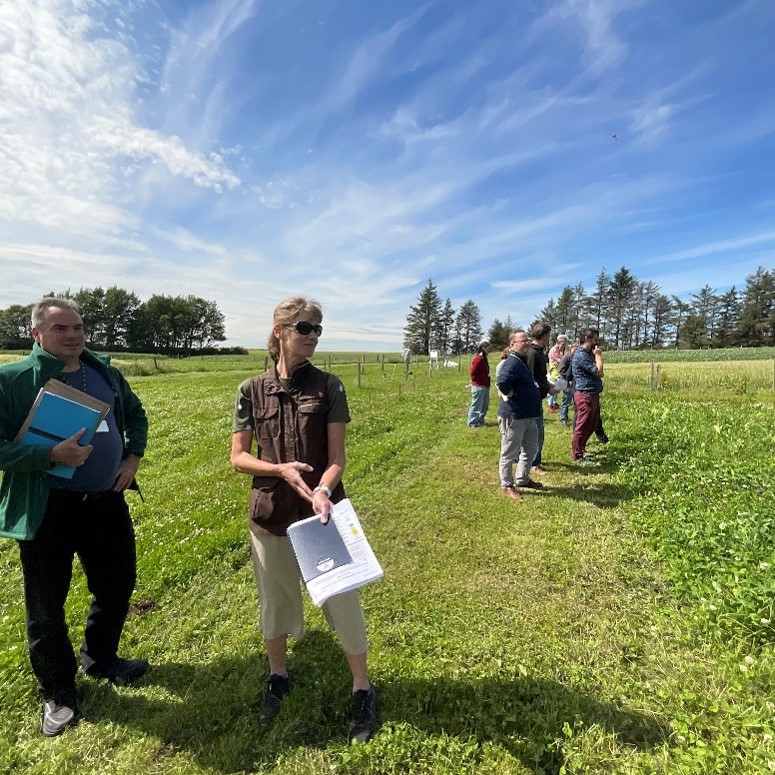
Photo of layout of the Tulloch plots. Source: Lorna Dawson.

Photo of grazing plot at Tulloch. Source: Lorna Dawson.
Summary
Christine Watson said that they would love for more researchers to come along and use these field trial resources as part of a living lab. She said “What we have done is to retain and further develop an established platform as a long-term resource so that the scientific questions can be asked. It’s as if we have now built the lab as well as putting the water in the taps and the soap at the sink". They are now ready and expecting more eager science questions to be asked on regenerative and alternative systems approaches to agriculture and scientists to come along and collaborate further on this ‘ACE’ platform! Please contact Christine on Christine.watson@sruc.ac.uk for further information.
2025 is the international year of cooperation, so it is a great year to all come together and collaborate more by worked together on such fantastic resources as we saw on our visit to SRUC, Aberdeen. A great day we all had with fabulous examples of outcomes having arisen from effective collaboration across research, industry, funders, and wider stakeholders. The future is good for the Scottish rotations and for Scottish farm systems, especially if we look after the ground beneath our feet.
Lorna Dawson, Knowledge Exchange Broker, SEFARI Gateway
